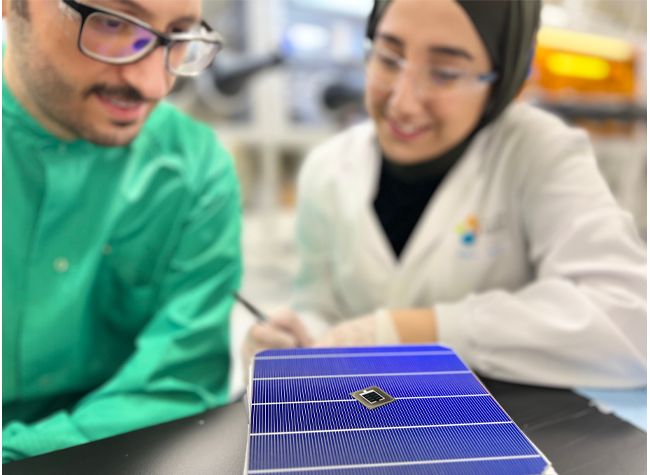KAUST (King Abdullah University of Science and Technology) has smashed the world record for solar cell efficiency of monolithic perovskite/silicon tandem solar cells with a certified power conversion efficiency (PCE) of 33.2%.
Tandem solar cells combine perovskite and silicon-based subcells in one device to capture and convert sunlight into electricity more effectively. This novel concept involved stacking two different types of solar cells on top of each other to create a device able to optimize the absorption and conversion of different light wavelengths into electricity. The PCE of these new solar cells is higher than their individual single-junction performances.
The KPV-Lab team, led by Dr. Stefaan De Wolf, a professor of materials science and engineering and interim associate director of KAUST Solar Center at KAUST, utilized a novel layering technique to create a highly efficient tandem solar cell that achieved a record PCE significantly higher than the previous record hit by Helmholtz Zentrum Berlin’s (HZB).
Dr. De Wolf commented on the significance of the research: "Perovskite solar cells are a swiftly evolving area of research, and this recent breakthrough marks a noteworthy stride in our quest to enhance the efficiency and affordability of solar energy. This concept involves merging perovskite cells with traditional crystalline silicon, resulting in a record-breaking efficiency of 33.2%, which is a remarkable accomplishment."
Over the last seven years, the KPV-Lab team at KAUST has been actively striving to make significant advancements in perovskite/silicon tandem solar cells. The team has undertaken several projects with the goal of attaining this objective, consistently establishing KAUST as a leading institution in the field of high-performance perovskite/silicon tandem solar cells.
The team's initial focus was on developing perovskite top cells on industrially compatible two-sided textured bottom cells. However, covering micrometer-sized pyramidal surfaces with perovskite material presented a major challenge. In 2020, the team overcame this issue and reported the first example of this concept with a certified PCE of 25.7%. Continuing their momentum, the team improved device performance to 27.4% in 2021 and reached 29.2% in August 2022.

Recently, thanks to the development of novel contacts and interfacial modifications which boost the current and voltage output of the cells, the PCE of the new cells reached 33.2%, which represents a new world record in its class. The recent result, certified by the European Solar Test Installation (ESTI), is now listed in NREL’s chart . Notably, this is not only a world record for perovskite/silicon tandem solar cells, it represents the highest PCE for any kind of two-junction tandem solar cells.
While Dr. Ugur and Dr. Aydin's contributions have been instrumental in the progress made by KPV-Lab, tandem solar cells require a multidisciplinary effort that was provided by other team members such as the c-Si bottom cell development task force, led by Dr. Thomas Allen, the KAUST Solar Center, whose infrastructure and technical support played a crucial role in the fabrication, testing, and characterization of the innovative solar cells.
Dr.Ugur commented on her contribution: “Drawing on my expertise in analyzing and visualizing losses in solar cells, I joined the KPV-Lab team to aid in the improvement of the performance of perovskite/silicon tandem cells. After years of intensive effort, our team has now established a new world record for such solar cells, signifying a significant milestone in the advancement of this technology.”
Dr. Aydin has been working on perovskite/silicon tandem solar cells since the team's establishment and his current research focuses on the scalability and stability of these ultra-efficient cells. “Currently, the global photovoltaic market size is around $100B and is expected to reach $250B by 2030. Market predictions suggest that tandem PV technologies will capture a market share of over $10B by 2032. In pursuit of this objective, we are actively investigating the scalability and reliability aspects of perovskite/silicon tandem solar cells, adhering to industrial protocols to ensure their practical application in the real world,” Dr. Aydin said.

